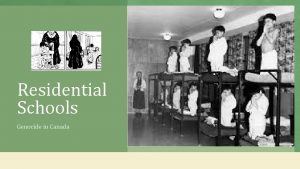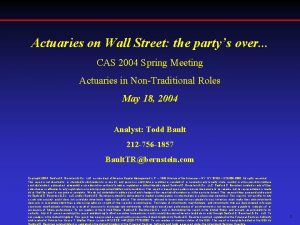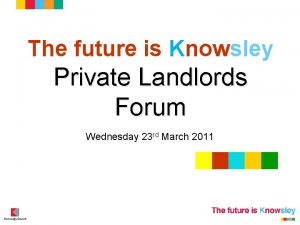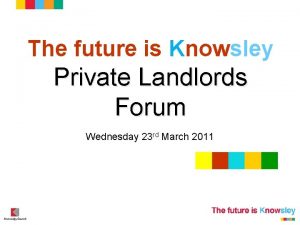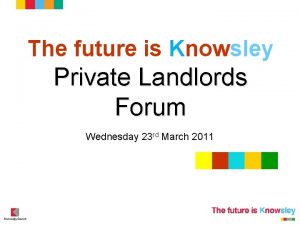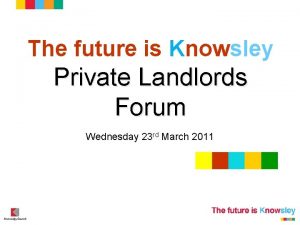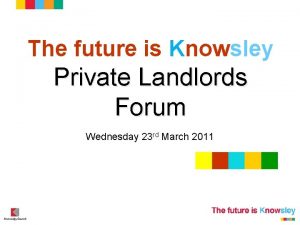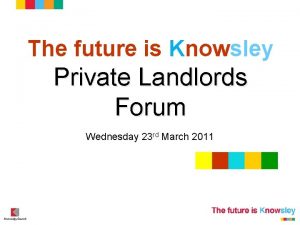The partys over How private residential landlords are















- Slides: 15

The party’s over: How private residential landlords are experiencing a changing policy and financial environment in Scotland Farhad Farnood and Colin Jones Heriot-Watt University

Introduction • Within Europe, however, the nature and experience of the PRS in different countries is diverse • Private landlords in the UK experienced a boom period between 1997 and 2007 • Drawn by the availability of mortgage finance and the combination of rental returns and capital growth. • ‘Golden decade’ was brought to an end by GFC • But this paper looks beyond this at the subsequent decade

Brief History Sketch • At beginning of 20 th century PRS was dominant tenure • It experienced legislative control of both rent levels and security of tenure for most of century • Owner occupation and social housing increased their share of the overall UK housing stock at the expense of PRS • PRS was moribund • Housing Act 1988 reintroduced landlords’ right to set market rents and introduced six month tenancies and reduced security of tenure

Beginnings of a Revival • 1988 Act was the potential basis for a revival • BUT the housing market was in downturn that stretched through first half of 1990 s • PLUS finance for landlords was difficult • In September 1996 a new mortgage product, ‘buy to let’, was launched tailored for people to invest in the PRS • Lenders required properties to be managed by a registered letting agency and be let on six month tenancies • Seeds were sown

Rise of Buy to Let • By 2001 BTL lending became increasingly mainstream with high street banks and major building societies offering landlord mortgages • Private landlords soon began to flock to the market attracted by the combination of rental returns and capital appreciation • Across UK in 2000 just 4% of all mortgage advances were BTL but by 2006 this figure had grown to 29% • Nearly 7 times BTL loans made in 2006 as 2001 as housing market boomed

Underpinnings of Boom • BTL landlords benefited from a lucrative combination of a booming property market and high and rising rental returns • Willingly assisted by mortgage lenders • Highly geared investment, funding most of purchase price with mortgage • Study in 2007 found BTL landlords had made an annual average compound return of 23. 25% per year over previous five years • Returns were remarkably consistent across all regions of the UK

Statistics of Returns • Rental returns of 5% • Asset values rising too • Within period 1997 to 2007 there were five years – 1999 and 2001 to 2004 when total returns were almost or greater than 20% • These assume 100% ownership • Geared returns will be a lot higher taking into account the actual capital invested (perhaps only 5% of property values) and mortgage repayments • Rises in asset values and remortgaging enabled some BTL investors to build their portfolios at a rapid rate

Global Financial Crisis 2008/09 • Extent to which BTL landlords were affected by GFC determined bypoint at which they entered the market • Early entry and the lower the leveraging the less the significant falls in house prices during 2008/ 9 would affect viability of a landlord’s investments • Those who entered at end of boom - highly leveraged may have become part of the dramatic rise in repossessions reported in 2009 and beyond • Dramatic profits accrued during boom but bust brought with negative equity, a collapse in returns and even repossessions • In 2008 10% of total repossessions were BTL with 4000 properties repossessed • Not until 2013 that repossession level began to return to pre-crisis levels

No. of BTL Repossessions in the UK -2008 to 2015 8 000 7 000 6 000 5 000 4 000 3 000 2 000 1 000 0 2008 2009 2010 2011 2012 2013 2014 2015

Post GFC Market Characteristics • Tightened lending criteria • Lack of growth in property asset values • Very low interest rates • Strong tenant demand • Unaffordability of home ownership


Tenure Shares Scotland 1993 to 2014 100% 90% 80% Percentage 70% 60% 50% 40% 30% 20% 10% 0% 1993 1994 1995 1996 1997 1998 1999 2000 2001 2002 2003 2004 2005 2006 2007 2008 2009 2010 2011 2012 2013 2014 Year Owner Occupied Privately Rented Socially Rented

Recent Tax Changes • Landlord buying after the 1 st April 2016, pays an extra 3% charge • Landlord in Edinburgh adding an average value property of £ 234, 658 to portfolio has an additional cost of over £ 7, 000 • Significant change to the treatment of mortgage interest relief on second homes including buy-to-lets • Over 4 yrs the rate at which relief on mortgage interest payments can be claimed will reduce down to basic tax rate of 20% • Higher rate (40%) tax payer landlords whose mortgage payments interest is 75% or more of rental income will no longer make a profit • From 1 April 2016 Wear and Tear Allowance which enabled landlords to claim tax relief of 10% of rental income replaced with deductible receipted expenses for capital expenditure on replacements/ refurbishments

Regulatory Changes • Since millennium landlords have been subject to a range of ‘consumer regulation’ on quality of the properties or way rent deposits are handled • In Scotland we have new changes in rent regulation and increased security of tenure • Not certain how landlords will respond

Conclusions • During boom economics of being a private landlord became irresistible • GFC brought these benevolent market conditions to an end • However, GFC greatly reduced the affordability of home ownership as lending criteria tightened • Result was PRS continued to grow as a proportion of all housing provision • Private landlords in Scotland have been affected by policy and legislation from both the UK government in Westminster and the Scottish government • Policies have reduced attractiveness of the PRS as an investment • Squeeze on landlords fiscally and in regulatory terms • But strong signs that PRS in Scotland is now a mature market based on the stability of tenure share, the more modest but consistent returns and the characteristics of regulation that match other mature private rental markets across Europe
 Private landlords tamworth
Private landlords tamworth Mikael ferm
Mikael ferm Hitler rise to power
Hitler rise to power Unscramble partys
Unscramble partys Landlords horne
Landlords horne Over the mountains over the plains
Over the mountains over the plains Siach reciting the word over and over
Siach reciting the word over and over Explain how to handing over and taking over the watch
Explain how to handing over and taking over the watch Gấu đi như thế nào
Gấu đi như thế nào Thẻ vin
Thẻ vin Thơ thất ngôn tứ tuyệt đường luật
Thơ thất ngôn tứ tuyệt đường luật Các châu lục và đại dương trên thế giới
Các châu lục và đại dương trên thế giới Từ ngữ thể hiện lòng nhân hậu
Từ ngữ thể hiện lòng nhân hậu Diễn thế sinh thái là
Diễn thế sinh thái là Vẽ hình chiếu vuông góc của vật thể sau
Vẽ hình chiếu vuông góc của vật thể sau Lp html
Lp html

















